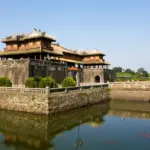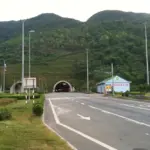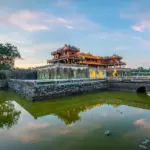Best Photo Spots in Hue Imperial City and Historic Sites by Ovuigo
Hue stands as the beating heart of Central Vietnam’s imperial history, where heritage and serenity blend with photogenic landscapes. The city’s crown jewel is the UNESCO-listed Hue Imperial City, a 19th-century citadel with moats, dragon mosaics, and ceremonial citadel gates. Walking through the labyrinthine palaces and royal halls, you enter a past defined by power and rich tradition. The Meridian Gate (Ngo Mon Gate) is a top viewpoint, opening to elegant imperial courtyards. For photographers, these medieval walls are a treasure—ornate details, vibrant colors, and the soft glow of early mornings create spectacular compositions. The entrance ticket for the Imperial City is around 200,000 VND.
Just beyond, you find the iconic Thien Mu Pagoda on the Perfume River. Its seven-story tower, lotus ponds, and riverside vistas offer prime golden hour shots—especially at sunrise. Entrance: Free.
For a blend of architecture and history, emperor’s tombs like Khai Dinh (150,000 VND) and Tu Duc (150,000 VND) feature distinctive carvings, ancient ponds, and a dream-like atmosphere. The historic Trang Tien Bridge, built of elegant steel arches, lights up beautifully at dusk.
Photographers flock to these sites to capture not just old stones, but living heritage—symbols like dragons and lotuses echo through every frame. Hue’s royal tombs, ancient architecture, and the gentle flow of Perfume River area form the roots of Vietnam’s cultural scene.
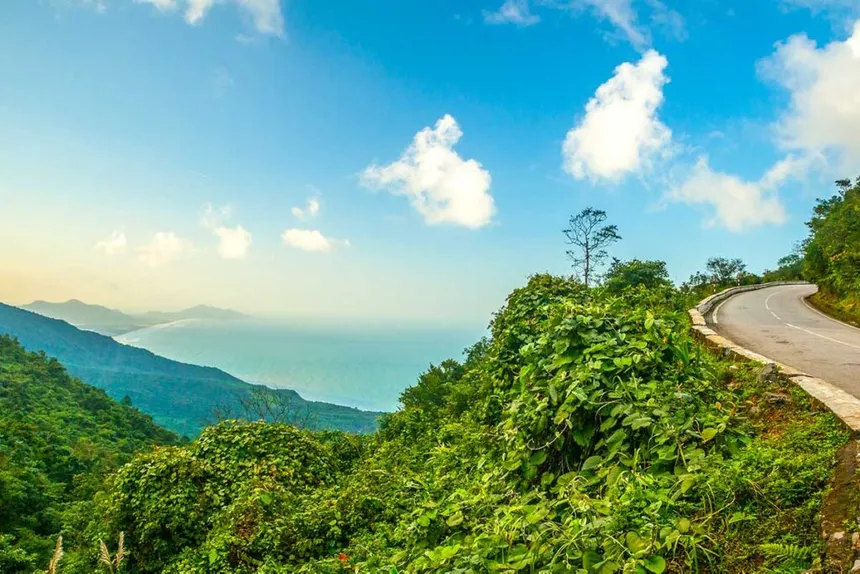
Tips for Hue Imperial City Photography: Lighting, Timing, and Techniques by Ovuigo
Great photography in Hue begins with understanding the play of sun, shadow, and weather. Arrive at the Hue Imperial City right at opening time (7:00 AM) to catch soft morning light and avoid tour groups with Ovuigo. Early morning and late afternoon (golden hour) are optimal; sunlight gently illuminates the intricate dragon mosaics, lotus ponds, and ancient citadel walls, enhancing colors and textures.
During midday, try shaded courtyards or interiors. Look for dramatic contrasts—light filtering through imperial gates or reflections in water features. For sunset, head to the banks of the Perfume River or classic bridges for fiery skies mirrored in gentle ripples. The region’s weather shifts fast, so bring a rain cover, especially between October and December (rainy season). Cloud cover can actually soften harsh light, producing beautiful, muted tones ideal for portraits or close-ups.
In frame, keep local attire, such as the traditional ao dai, or statues of dragon—symbols of power—in focus. Embrace wide angles to capture the full grandeur of citadel gates, then switch to a zoom lens for intricate details on imperial crests and lantern boats. Mind your subject distance and compose thoughtfully—position people or elements according to the “rule of thirds” for natural, balanced shots.
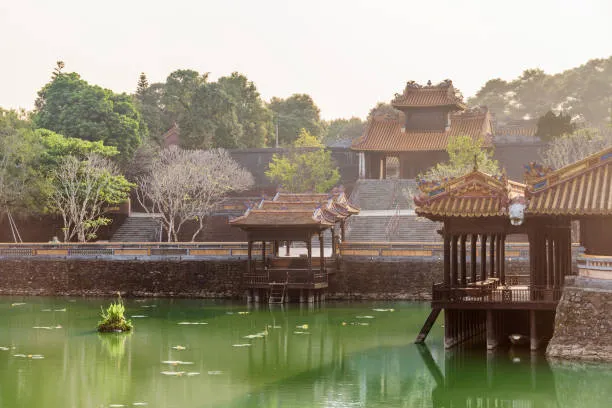
Iconic Landmarks and Hidden Gems: What to Photograph in Hue
While headline sites like Khai Dinh Tomb, Tu Duc Tomb, Forbidden Purple City, and Minh Mang Tomb (all about 150,000 VND entry unless otherwise noted) steal the show, Hue hides more than imperial splendor. Seek out incense villages where scarlet incense sticks dry in tribal patterns, authentic cyclo rides weaving through hidden alleys, and tranquil lotus ponds—each telling a unique story of Vietnam’s Central Region.
Discover the poetic geometry of octagonal pavilions, elaborate dragon mosaics on forgotten walls, and doorways emblazoned with the imperial crest. Visit Dong Ba Market (see on map) for frames lively with conical hats, bright produce, and the daily buzz. Dawn and dusk on lantern-lit bamboo boats, especially near the Trang Tien Bridge, create haunting reflections—ideal for those chasing the soft, mysterious mists that define Hue’s rare attributes.
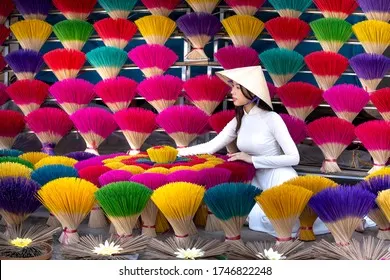
Capturing Local Culture: People, Traditions, and Daily Life in Hue by Ovuigo
Great travel photos celebrate culture—the spirit of place revealed in daily life and tradition. Throughout Hue, you’ll find women in purple ao dai—the region’s trademark traditional costume—striding past moss-covered walls or cycling by the Perfume River. At Dong Ba Market, vendors in conical hats sell produce, incense, and fabrics—perfect for capturing stills of Vietnam’s living heritage. Always ask permission before taking portraits; a smile and a friendly gesture are often met with warm acceptance.
Seek the sounds and colors of imperial court music during special performances or cultural festivals—attire, instruments, and dancers stir a royal nostalgia. Look for details like lotus blossoms, ceremonial gates, and the soft shadows in quiet alleys. The message is clear: in Hue, people and monuments belong to a shared story. Photographers should show respect, keep a respectful distance, and be ready to explain their intent, especially when photographing religious rituals or elders by Ovuigo.
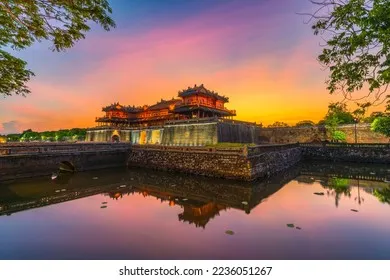
Comparing Hue with Other Central Vietnam Photography Destinations with Ovuigo
Hue, Da Nang, and Hoi An together create a photogenic trifecta. Yet, Hue stands apart for its royal backdrop—no other site in Vietnam has such a concentration of ancient walls, citadel moats, and tombs set on lotus-strewn lakes. Da Nang offers vibrant cityscapes, bridges, and mountainous coastline; Hoi An is best for lantern-filled rivers and yellow ochre facades. Adventurers may venture to Phong Nha’s caves, Quang Tri’s war relics, or Bach Ma’s cloud-wrapped mountains for dramatic natural imagery.
While Hoi An is romantic and Da Nang modern, Hue’s unique qualities—its historical depth, ornate architecture, and tranquil atmospheres—cater to photographers craving authenticity and a slower pace. Dramatic light, moody mists, and centuries-old artistry ensure images that never fade into blur or modernism.
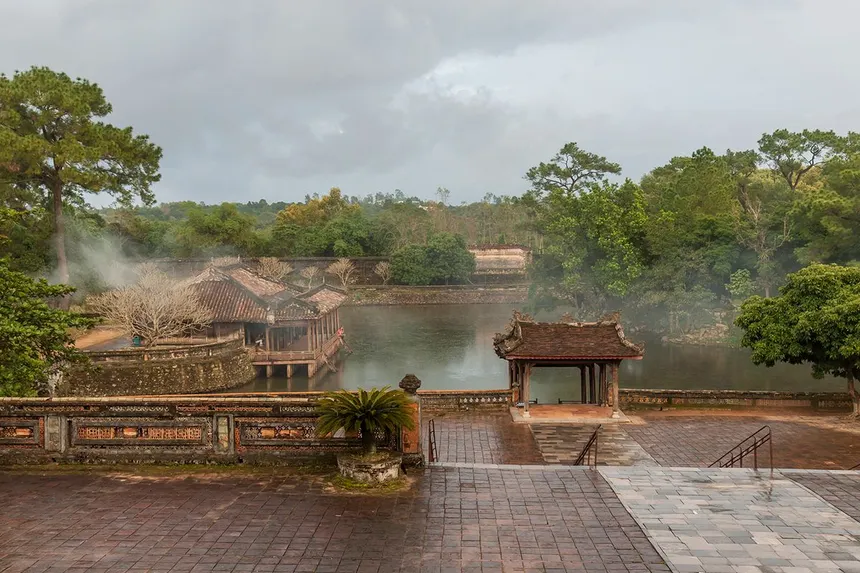
Planning Your Hue Photography Tour: Practical Advice and Resources
Start by choosing the right season. From February to April, Hue’s weather is most pleasant. Summer brings intense sunlight and lotus blossoms, while the October–December rainy season provides atmospheric mists (but prepare your gear for moisture). To reach sites, use cyclos for local color, or hire a boat trip along the Perfume River for water-level perspectives.
Tickets for key sites average 150,000–200,000 VND—a combined ticket can save costs if you cover royal tombs and the Imperial City in one day. Early arrivals beat crowds, especially at the Forbidden Purple City or Khai Dinh Tomb. Guided ovuigo tours can enrich your visit with historical context, but solo travelers with a camera and a plan can see 90% of highlights independently. Bring rain protection, an extra battery, and memory cards; sturdy walking shoes are a must for the sprawling complexes. Review etiquette for religious places and always greet locals with a smile.
**We don’t run tours — we craft experiences. Each journey is a story written just for you, designed for those who wish to explore Vietnam slowly, deeply, and meaningfully. No fixed itineraries. No crowds. Just you — and the moments that truly matter. **Contact us via Whatsapp +84868319161.
For more inspiration, beautiful stays in the region include The Manor Hoi An, Hola 1, and Hola 2. Explore, capture, and let every image tell the story of Hue’s timeless soul.

